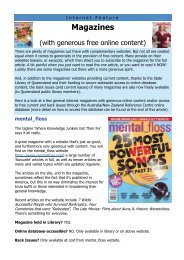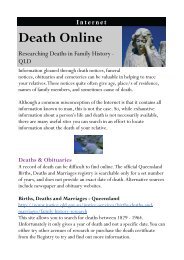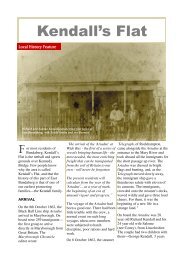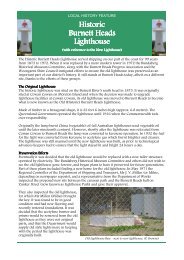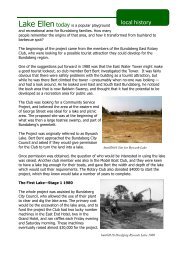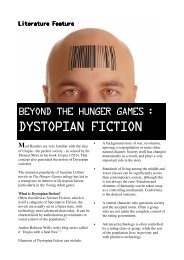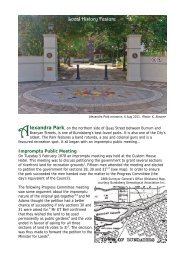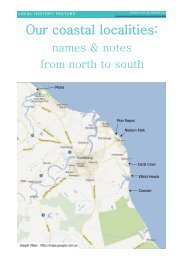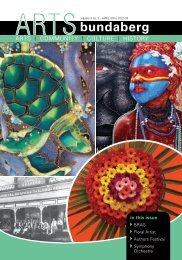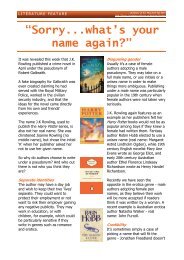Vol 5 No 2 Dec 2008-Mar 2009 - Bundaberg Regional Libraries
Vol 5 No 2 Dec 2008-Mar 2009 - Bundaberg Regional Libraries
Vol 5 No 2 Dec 2008-Mar 2009 - Bundaberg Regional Libraries
- No tags were found...
You also want an ePaper? Increase the reach of your titles
YUMPU automatically turns print PDFs into web optimized ePapers that Google loves.
ARTS BUNDABERGcakes were most often used for specialoccasions. <strong>No</strong>wadays, mud cakes arevery popular. While fruit cakes can bemade months in advance and ‘covered’weeks before needed, mud cakes mustbe decorated the day before as the cakecontains no preservatives.As would be expected, a great manyhours can go into the decorating of acake. Sometimes a decorator can spenda whole day on a cake and not seemto have got much done. Other cakesrequire preparations weeks in advance,as certain elements have to be madeand dried before other elements can beadded. But for cake decorators it is alabour of love.Displays, Fundraising andCharitiesOf course, if you put in all the hardwork of decorating the cake you like it tobe seen! Several members enter theircakes into the <strong>Bundaberg</strong> Show, andperiodically the group is invited to displayat various functions around <strong>Bundaberg</strong>.To raise funds the group sellshandmade and decorated sugar Eastereggs, for which they are well-known,and raffles off baskets of goodies. Theyusually do this from stalls in the mainstreet around Easter and Christmas.At the end of each year the group alsodonates cakes to various charities,including the Make A Wish Foundationand Angel Flight.MeetingsThe <strong>Bundaberg</strong> Branch of theQueensland Cake <strong>Dec</strong>oratorsAssociation meets on the 3 rd Saturdayof each month at 9.30am at theNeighbourhood Centre in Targo Street.New members are always welcome. Ifyou’re interested in joining the group youcan go along to one of their meetings, orphone President Phyllis Henderson on4159 2051 or Secretary Ann South on4153 1808 for more information.Catch the last week of their display inthe Library from 1 st – 5 th <strong>Dec</strong>ember.Special thanks to Phyllis Hendersonand Ann South for providing informationand photos for this article.Peta Browne<strong>Bundaberg</strong> <strong>Regional</strong> LibraryCOMMUNITY 7
Apple Tree Creek Flood15-16 <strong>Mar</strong>ch 1937In <strong>Mar</strong>ch 1937 a cyclone was makingits way around the top of Australiafrom the Kimberley region in WesternAustralia to south east Queensland.Once it arrived off Queensland, manyparts of our State experienced heavyrains and flooding, most notably theApple Tree Creek (spelt “AppletreeCreek” in the newspapers of the day)area between <strong>Bundaberg</strong> and Childers.Rain, rain, rainTwelve inches of rain fell in the areaup to about Monday afternoon, 15<strong>Mar</strong>ch. That afternoon at about 4pm aheavy storm dropped another delugein a very short period. In one hour thecreek rose 6 feet (1.8 metres). Between5-6pm on the night of the fifteenth,Apple Tree Creek was in full flood.Hotel washed awayWith the creek running behind theApple Tree Creek Hotel, it was alwaysgoing to be susceptible to a flood ofthis magnitude. Having been destroyedby fire four years previously theHotel had been rebuilt on higher blocks,which were all that remained after thefloodwaters had passed through.The Hotel, with five people inside,was picked up and torn apart by thefloodwaters and deposited in variousspots around Apple Tree Creek.Licensee Mr J Cronin, Mrs Cronin, MrsFoster, her son Cecil Foster, and HenryPearce were in the Hotel at the time.According to the <strong>Bundaberg</strong> Daily Newsand Mail on 16 <strong>Mar</strong>ch 1937 the fiveoccupants jumped free of the Hotel onlyto be carried along by the floodwaters.Mr Cronin managed to grab hold of hiswife and Mrs Foster but then lost hisgrip on Mrs Foster.Observers on dry land noticed themfloating down the creek and staged arescue effort. Mr and Mrs Cronin werehelped ashore, but Mr Cronin dived inagain to go after Mrs Foster. He foundher clinging to a tree and held on withher until they could both be rescued.Cecil Fosterwas rescuednear the site ofthe Hotel andHenry Pearcewas found onthe oppositeside of thecreek. Allwere takento hospitalsufferingshock andexhaustion.Mr Croninwas hailed ahero.8 HISTORY
Art for theRicebubbleswere strewn on theground, gleaming sugarcrystals adorned the walls and thesmell of fresh coffee filled the air. <strong>No</strong>tperhaps the scene you would expect tosee in an art gallery, but this was oneof many art experiences provided forchildren at the <strong>Bundaberg</strong> <strong>Regional</strong> ArtGallery’s newest children’s space, theKidz Corner.The current building that is the<strong>Bundaberg</strong> <strong>Regional</strong> Art Gallery has alsobeen home to Customs House (1902),the Commonwealth Bank (1921) and theLibrary (1978). Operating out of a nonpurpose built art gallery on the one handpresents a challenge to find suitableuses of spaces, while on the other handthe spaces that do exist tend to havehistory and character.The challenge was to find a permanentchildren’s space, somewhere wherechildren would feel safe and where theycould build on the gallery experience bylearning through free play. So what wasonce an unsightly storage space underthe stairway that leads from Gallery Oneto Gallery Two has now become the KidzCorner, a small but dedicated space forchildren.Every six weeks, or thereabouts,the <strong>Bundaberg</strong> <strong>Regional</strong> Art Gallerychanges its exhibitions in all three galleryspaces and installs new exhibits. In aneffort to further connect children withthe concepts and techniques in theexhibitions the Kidz Corner activitiesare themed to one of the exhibitions.In this way children can experience theexhibition and then become involvedin activities that explore or furtherexplain the ideas, viewpoints and worksexpressed in the exhibition. Activitiesoffered are all practical based, freeand self-guided. Where possible theopportunity for children to take hometheir artworks is presented.Through meeting artists andrunning art activities for children Ihave discovered that art is very muchabout problem solving. Very often theresult you want to achieve and whatactually physically happens can be verydifferent, requiring you to problem solve,discuss issues with others or do further10 ART
Young atHeartARTS BUNDABERGresearch, all of which helps to build skillsand confidence which is very importantin children. The Kidz Corner activitiesencourage this process to occur throughopen ended activities.The Kidz Corner is also a space wherefamilies can sit with their children,support them in their activities andobserve their children at play.Kidz Corner by name but not alwaysin reality! The space is often usedby couples and backpackers hard atwork constructing an imaginary body,stamping designs onto paper, tracingthe letters of their name using a ceramicalphabet or contributing to a collaborativemosaic piece. It is great to see thatadults enjoy the space too.Since opening in <strong>No</strong>vember 2007 theKidz Corner activities have ranged fromlearning about Greek and Indigenouscultures, to creating a complex weavingtaking up the entire Kidz Corner, makingorigami figures and shapes or as in thecase of the rice bubbles, sugar andcoffee, discovering food as art.It is throughspaces such asthe Arts Centre’s KidzCorner that children arepresented with the opportunity for selfexploration,discovery, individual andcollaborative play. <strong>No</strong>t all children willgo onto pursue a career in the arts butit is hoped that those that have beenexposed to art will develop skills inexpressing their opinions, acknowledgingdiffering points of view and learningcreative solutions, all necessary lifeskills.Further plans are underway to provideanother dedicated children’s art spaceupstairs adjoining the Green Room, theArt Gallery’s library. So whether you area big kid at heart or a little kid we inviteyou to explore, discover, create and playyour way through our latest Kidz Cornerart experiences. See you under thestairs!Roana O’Neill<strong>Bundaberg</strong> <strong>Regional</strong> Art GalleryART 11
BOOKSCelebratingPenguinsPenguins come in many different colours– blue, orange, green and of course, black.Books, that is, not birds. In <strong>2008</strong>, PenguinBooks have released a retro collectionof titles under the Penguin Celebrationsbanner, and it’s a timely reminder of justhow important Penguin has been to theworld of books.BeginningsAllen Lane, the director of The BodleyHead publishing group, was the brainchildbehind Penguin. After visiting his goodfriend Agatha Christie one weekend, hewas stuck on a railway platform looking atmagazines and reprints of old classics inNewsagents’ shops. Lane decided thenthat good contemporary fiction should bepublished cheaply, and distributed widely– not just in book shops, but tobacconists,newsagents and chain stores as well.Lane felt that the price of a packet ofcigarettes (around sixpence at the time),was the price a book should sell for, andit should be compact enough to fit in apocket or handbag.Lane went back to his office and askedfor suggestions for a company name –something ‘dignified but flippant’, andhis secretary suggested Penguin. <strong>No</strong>tfinished with his office employees quiteyet, Lane sent junior clerk Edward Youngoff to London Zoo, where the 21 year olddrew what became the first version of thePenguin logo. He also created the initialdesign for the books, with their iconicthree horizontal bands of colour, andcentral white panel.The Penguin brand was launched in July1935, and the low cost of the books ledmany in the industry to believe that thisventure would make profits unlikely.Jonathan Cape was the first publisherLane approached for titles, and manyyears later Cape recalled: “I thought hewould go bust and thought I’d take fourhundred quid off him before he did…”.However, Lane proved him wrong,especially after chain store Woolworthspurchased 63,000 books, which allowedAllen Lane to pay for the venture outrightand set up Penguin as a separatebusiness from The Bodley Head in 1936.AuthorsBecause manypublishers hadnot believed thatPenguin would last,Lane had been able topurchase publicationrights to some novelsat very good prices.The public obviouslyagreed with hischoices, becauseby <strong>Mar</strong>ch 1936Penguin hadprinted its onemillionth book. Thefirst twenty titles12 BOOKS
published includedA Farewell to Arms,by Ernest Hemingway,The Mysterious Affair atStyles by Agatha Christie, TheThin Man by Dashiell Hammettand The Edwardians by Vita Sackville-West.Lane had decided early on to split hispublications into colour coded covers, toallow readers to choose their favouritegenres with ease. Orange and whiterepresented general fiction, green andwhite for crime fiction, blue and white forbiographies and red and white for traveland adventure.ReactionThe Industry was still divided on the costof the books and the paperback revolutionthat ensued, but Allen Lane “believedin the existence in this country of a vastreading public for intelligent books at alow price, and staked everything on it…”.George Orwell was quoted as saying that“the Penguin Books are splendid valuefor sixpence, so splendid that if otherpublishers had any sense they wouldcombine against them and suppressthem”, while George Bernard Shaw, inhis usual concise manner, commented“If a book is any good, the cheaper thebetter.”The Publishing HouseWith the success of the first Penguinprinting, and the independence ofPenguin books from The Bodley Head,came the necessity to organise aseparate publishing premises. PenguinBooks set up shop in the Crypt of theHoly Trinity Church on <strong>Mar</strong>ylebone Road,with a fairground slide used as a deliverychute from the street above. These wereonly temporary premises though, and in1937, with Penguin publishing more than3 million books in that year, the companymoved to a warehouse near the futuresite for Heathrow Airport.BOOKS 13
quite a lot of attention and praise from<strong>Bundaberg</strong> residents.The Memorial’s FoundationsThe foundations were constructed bylocal contractor Mr W.P. Guthrie and thefoundation stone was officially laid byGeneral Sir William Birdwood, who waspopularly known as “the Soul of ANZAC”,on 15 May 1920.Despite it being a damp day a crowdof several hundred attended, with thebalconies of the Post Office and RoyalHotel also filled with spectators. The<strong>Bundaberg</strong> City Band played during theceremony and Sir William presented anumber of medals to returned soldiers,and spoke with mothers, widows andrelatives of fallen soldiers.On 13 October 1920 the tablet bearingthe inscription of the laying of thefoundation stone was laid in place, tomuch less fanfare.The Memorial<strong>Bundaberg</strong>’s Fallen Soldiers’ MemorialStatue originally had a base of threechiselled trachyte steps. However, sincethe addition of the roundabout in 1992,only one of these steps is now visible.Resting on the steps is the die which is1.8 metres (6 feet) square. The base ismade of chiselled trachyte and at eachcorner is a pedestal of polished trachyte.On top of the pedestals are red granitepilasters which hold a polished granitefrieze and a chiselled trachyte cornice.On each side of the die are panels ofpolished trachyte overlaid with redgranite in which the names of the fallenhave been cut and gilded.The frieze contains the inscription“The Great War of 1914-18” and alsothe tribute. On top of the cornice isan octagonal base of chiselled trachyteholding a circular polished trachyteplinth, with a column of red granite, 60centimetres (2 feet 3 inches) in diameter,finished in the Ionic style, sitting on theseoctagonal bases.The Memorialstandsapproximately12 metres high,including thestatue. It cost atotal of £1885/0/3.This total includesthe cost ofthe statue, thefoundations,the engraving,the architectfee, postage,clerical work,etc. As a resultof the effortsof the Soldiers’ReceptionCommittee, andthe contributionsof local people,when thememorial wasunveiled it wasentirely free ofdebt.The DiggerStatueFinally, at the top of the Memorialstands the Digger. The Digger is madeof Carrara marble from Italy and standson a base of white Ulam marble. AMr Illingworth, who at the time wasregarded as one of Australia’s leadingmodellers, created a model of the Diggerwhich was then sent to Messrs. Anselm,Odling and Sons in Carrara Italy, where“the finished statue came from thehands of one of the world’s most famoussculptors”. 1Carved from a solid two ton blockof marble, the Digger is approximately7 feet (2.1 metres) high and weighsapproximately 1.5 tons. He is shownhead bowed, resting on arms reversed,and with his left leg bent in a relaxedstance. The stump behind him is aHISTORY 19
HISTORYcommon means of support for diggermemorial statues.UniqueThe digger is the most popular formof memorial in Queensland. However,<strong>Bundaberg</strong>’s memorial is unique inseveral ways.The use of trachyte is quite unusualfor Queensland memorials and ismore commonly seen in memorials inNew South Wales. Also uncommonto most digger memorial statues isthat our Digger is shown carrying abackpack. <strong>Bundaberg</strong>’s Fallen Soldiers’Memorial Statue is also only one of twoin Queensland which remains intactin its original setting in an intersection(the other is in Aramac). It not onlycommemorates soldiers who fell in theFirst World War but it also recognises theonly local soldier who lost his life in theBoer War, Lt. John Leask.The Memorial is also an unusualexample of architect F.H. Faircloth’s work.He is more commonly associated withbeing “responsible for almost everymajor building in <strong>Bundaberg</strong>” 2 and therebuilding of Childers after the 1902 fire.ANZAC Day 1921Despite the Memorial not being fullycompleted (the statue of the Digger stillhad not arrived from Italy), ANZAC Dayservices in 1921 took place at the site ofthe Memorial, then consisting only of thebase and column.Arrival and Placement of theStatueThe statue arrived in <strong>Bundaberg</strong> onTuesday 5 July 1921 by the s.s. Tinana.Messrs. Keys Bros. carted the statuefrom the wharves to the vacant blockopposite the Post Office.For the purpose of lifting the figure…Messrs. Keys Bros. have erected apole fitted with the necessary tacklealongside the column, and whenmaking the lift this will be tilted atsuch an angle as will ensure thatthe figure will be easily swung intoposition. It is interesting to note inthis connection that the pole that isbeing used was once the mast ofthe s.s. Nelson which ship it will beremembered, sprang aleak [sic] andwas washed ashore and wreckedon the rocks adjacent to Mr O. J.Gruter’s cottage at the Sandhills[Bargara]. 3The digger was placed on top of thecolumn on Thursday 7 July 1921. Theraising of the statue was watched by acrowd of about 500 spectators, includingmany amateur photographers.The Unveiling CeremonyThe unveiling ceremony took placeon Saturday 30 July 1921. All returnedsoldiers were requested to attend inuniform and next of kin of fallen soldierswere asked to apply for a pass whichallowed them access to seating in aspecial enclosure. Limited seating wasalso available on the Post Office balconiesat a cost of 2/-. Souvenir buttonsportraying the statue in miniature weresold for 1/- each.Major General Charles Henry Brandwas invited to officially unveil the newmemorial. Born in Ipswich, the Majortrained as a teacher and for a timetaught at Central Boy’s School and <strong>No</strong>rth<strong>Bundaberg</strong> School. He served in the Boer20 HISTORY
War and the First World War before goinginto politics after his retirement from themilitary in 1933.For the ceremony the statue wasdraped with the Union Jack and Australianflags and when Major General Brand wasready to unveil, he simply released thepin holding the flags. A minute’s silencewas observed, three shots were fired bythe firing party, and then Bugler Steptoeplayed the Last Post.After the official unveiling the FallenSoldiers’ Memorial Statue was handedover to the <strong>Bundaberg</strong> City Council astrustees.Other CommemorationsIn addition to the inscription for BoerWar soldier Lt. Leask, a plaque honouringdistrict women who served in theAustralian Defence Forces was placedbeside the memorial in 1993. It waspresented by the <strong>Bundaberg</strong> & District ExServicewomen’s Association.Site of the StatueBack in late 1962 the position ofthe memorial was causing someconsternation to <strong>Bundaberg</strong> motorists.The introduction of a new “diamond turn”regulation at intersections around thecity meant that some felt the monumentarts bundabergcreated a traffic hazard by taking up toomuch space in the intersection. Trafficlights were installed and were eventuallyreplaced by a roundabout in 1992 as partof the CBD’s beautification project.Current TimesThe memorial is listed on theQueensland Heritage Register and onthe Register of the National Estate(Australian Heritage Database). It is thesite of memorial services in the City eachANZAC Day.Images from the Picture <strong>Bundaberg</strong>collection, donated by Doug Rattray, P. D.Johnson and D. Strathdee.Peta Browne<strong>Bundaberg</strong> <strong>Regional</strong> LibraryReferences:1<strong>Bundaberg</strong> Daily News, 30 July 1921.2Watson, D. & McKay, J. 1994. QueenslandArchitects of the 19 th Century.3<strong>Bundaberg</strong> Daily News, 6 July 1921.<strong>Bundaberg</strong> Daily News, 14 Oct 1920; 15-17 May1920; 6 Jul – 1 Aug 1921.<strong>Bundaberg</strong> Mail, 14 Oct 1920; 15 May 1920; 8 Jul –1 Aug 1921.<strong>Bundaberg</strong> News Mail, 2 Oct – 4 <strong>Dec</strong> 1962; 12-15Jan 1963; 26 Sep 1963;13-14 <strong>No</strong>v 1992.McIvor, Shirley & Trevor. 1994. Salute the Brave….Australian Heritage Database – http://www.environment.gov.au/heritage/index.htmlQueensland Heritage Register – http://www.epa.qld.gov.au/chims/basicSearch.htmlAustralian Dictionary of Biography Online – http://www.adb.online.anu.edu.auHISTORY 21
DVD: REVIEWTORCHWOOD – The complete First SeriesWho or what is Torchwood?It’s an organization separate fromthe government, outside the policeand beyond the United Nations. Theirpurpose – to investigate unexplainedand extraterrestrial events in their area,and scavenge any alien technologyfound for research. And there are manyunexplained incidents, because theTorchwood Institute in Cardiff, Wales issmack dab on top of a rift in time andspace.Torchwood is also one of the mostpopular TV series showing in the UK,although it has yet to be widely known inAustralia. The series is an intriguing mix ofdrama, paranormal, romance and horror– not dissimilar to The X-Files, but with adecidedly British slant. The ‘eyes’ of theseries is WPC Gwen Cooper (Eve Myles),who comes across the mysterious teamfrom Torchwood while investigating a22 DVD: REVIEWmurder. After seeing them bring a deadman back to life, and tracking them totheir underground facility, the policeofficer gets a little too close to the truth.Unfortunately, if you get too curiousabout the Torchwood group, you’re eitherconscripted or eliminated, so GwenCooper gets an offer she literally can’trefuse. Ex-WPC Cooper becomes thenewest member of the Torchwood team,and the viewer follows her journey as sheis initiated into the secrets behind thisorganization.The Origins of TorchwoodThe writers and producers of thecurrent Doctor Who series had beenwanting to try a new type of crossoverSF/Crime show, and the decision wasmade to develop a post-watershed show,(shows that screen after 9pm with adultthemes). The writers were allowed moreleeway with the content of their stories,with BBC3 Controller Stuart Murphydescribing Torchwood as “sinisterand psychological”, and writer RussellDavies as “… British sci-fi paranoidthriller, a cop show with a sense ofhumour.”The producers and writers wereaiming for an ensemble show,with the five main charactersgiven equal screen time. It wasinevitable though, that the characterof Captain Jack Harkness (JohnBarrowman), quickly became thefan favourite, especially as hischaracter had appeared in a guestrole in several Doctor Who episodes.
The CharactersThe mysterious leader of TorchwoodCardiff is apparently ageless andimpossible to kill, although no cluesare given as to why and how. In thewords of Barrowman, his character isa combination of “..hero, swashbuckler,rogue and dark horse, with a mysteryat his heart.”. Harkness appears to liveat the Hub, in Torchwood, and have nofriends or relatives, just his work.Newcomer Gwen Cooper is the‘eyes’ of the show – the viewer seesher perspective on the events thathappen, and there’s a good reason forthat. The writers wanted the viewer toexperience the feelings of someonewho had just discovered that fantasy isreality – or, as Producer Richard Stokesputs it “… how would you feel if youdiscovered the Batcave, or JurassicPark? There would be a combinationof joy, wonder, fear and terror andexcitement – that’s what we wereaiming for.”.The DVDThe first series set is comprised ofseven discs, with 13 episodes and arunning time of approx. 15 hours. Atthe end of each episode is a 10 minutedocumentary Torchwood <strong>Dec</strong>lassified,which interviews the cast and writersabout the storyline.Given the plot lines of some ofthe episodes, the rating is of courseMA15+, with strong violence, sexscenes and adult themes. Don’t letthat put you off though, if you likean addictive, thought- provoking,humourous and slightly scary show.Executive Producer Russell Davies putsit best when he describes Torchwoodas ‘adult, paranormal, strange, urbanstorytelling…’Torchwood – the First Season isavailable for loan from the <strong>Bundaberg</strong><strong>Regional</strong> Library Service.Sue Gammon<strong>Bundaberg</strong> <strong>Regional</strong> LibraryTORCHWOOD TORCHWOOD TORCHWOOD TORCHWOODDVD: REVIEW 23
YOUTH: BOOK REVIEWby Stephenie MeyersTwilight is a thrilling book of love,secrets and danger. When Isabella Swanmoves to the dreary town of Forks shefinds her life turned upside down. Whenshe meets Edward Cullen she delvesinto the realms of the unknown and thetantalisingly scary. With his pale skinand golden eyes, Bella is sure there ismore to Edward than meets the eye.Edward and his family, Dr Carlisle andhis wife Esme are vampires, thoughno one knows their dark secret. UntilBella. The more Bella becomes close toEdward, the more she places herselfand those around her in danger. Of allthe marvellous characters in this book,Edward stands out. He is intriguingenough to keep you hooked - you neverquite know what he will do next.The characters in Twilight are all sovery easy to relate to. Falling in love andchange are quite close to many people’shearts. Edward and Bella especiallymake you feel like you’re their old bestfriend and you have to help them, theycannot be in pain. You can’t help fallingin love with them, they are so perfect.Everyone meshes together so well24 YOUTH: BOOK REVIEW
arts bundabergand though they are all different, theycomplement each other perfectly.Have you ever had to stop anduse some self control? Or tried notto be scared? If so you will relate toTwilight. All the characters seem tofind the people they want to be frominside themselves, and the strength toovercome their demons.Twilight is the talk of the town, andI agree with all those fans who love it.I am in love with this book, it is an alltime classic that you cannot put down.The relationship between Bella andEdward’s family is not the main focus ofthe book, but it is magical all the same.Some family members are jealous ofBella, while others clearly adore her. Theclashes and rivalries make it my favouritepart to the book. The relationship of Bellaand her father is always an awkwardone, and sometimes I feel it detractsfrom the book a little. They never seemlike a father and daughter, and Bellatends to be left a little alone in Forkswithout him.I recommend Twilight to anyone wholoves a good read. You don’t have to lovefantasy or horror - just books - to gethooked on this one. Twilight does getscary so it isn’t one for young readers,but older children, teens and adults willall love it. So sink your teeth into Twilightand find yourself in the most beautifulpart of the day.Emily McWhirter Peddlesden,13 years.YOUTH: BOOK REVIEW 25
ARTLandscape CollectionAcross the Arts Sector regionalgalleries are the caretakers ofcollections. The collections of regionalgalleries frequently serve as the localcommunities’ source of viewing local,state, nationally and internationallysignificant Artists and works of art.Furthermore, regional gallery collectionsprovide a platform and basis forresearch, exhibition and educationprograms and cultural outreach to thelocal communities. With these variousfunctions, the collections of regionalgalleries are as diverse in style andmedium as the themes and subjectsthat they deal with. However beneaththis initial layer, there is a method to themadness of the collecting decisions ofregional galleries.Sub-CollectionsSub-Collections are often used tocontextualize the selection of artists,themes and mediums within thegallery’s overarching collection. Thesesub-collections bring together similarworks, in either period of creation,style that the work is undertaken in,or perhaps the medium or the formin which the work has been created.These sub-collections stimulate furthermeaning and give strength to collectionsand institutions alike. <strong>Regional</strong> galleriesthrough Australia have embraced thesignificance of sub-collections. ArtSpace Mackay has recently recognisedand developed a collection with a focuson artist books, the Cairns <strong>Regional</strong>Art Gallery has a particular focus onAbove image:Pete <strong>Mar</strong>tin, New Day, 2007, oil on canvas, <strong>Bundaberg</strong> <strong>Regional</strong> Council Collection,<strong>Bundaberg</strong> Arts Centre Collection26 ART
Aboriginal and Torres Strait Art, and theToowoomba <strong>Regional</strong> Art Gallery has afocus on Wearable Arts.After exploring the sub-collectionsof Queensland’s regional art galleries,the <strong>Bundaberg</strong> <strong>Regional</strong> Art Gallerynoticed some voids in the collectionfocuses of the galleries. With someopportunities to collect a genre that wascurrently not a focus of any Queensland<strong>Regional</strong> Gallery, in line with the contentof the artworks currently held in theGallery’s collection, and similarly inresponse to what has been noted as anoverarching passion of the <strong>Bundaberg</strong>arts community, the <strong>Bundaberg</strong> <strong>Regional</strong>Art Gallery has recognised its collectionfocus of landscape. This sub-collectionenables the collection to embrace theregion’s diversity, in which it is a fabric ofrural, city and costal communities.Dr Egmont Schmidt CollectionThe sub-collection focus of landscapeswas a natural progression for theGallery, as since its inception, the<strong>Bundaberg</strong> Arts Centre was gifted thephilanthropic collection of Dr EgmontSchmidt, a sub-collection that forms thenucleus of the Art Centre’s collection.He had a unique eye for talent and apassion for the Arts, and through thedonation of this collection from the<strong>Bundaberg</strong> Arts Society, the <strong>Bundaberg</strong>Arts Centre has become the caretakerof works of art from the early 20thcentury. This collection holds artworksby significant Australian artists such asWilliam Bustard, Lloyd Rees and ErnestBuckmaster, and many more Australianartists who were involved with theHeidelberg School. The School was arenowned Australian plein air paintingmovement that stemmed from the late19th Century, a movement that has beenacknowledged as the significant point ofdeparture for post-colonial Australian Art.arts bundabergPercival Charles Lindsay, nd, <strong>Bundaberg</strong> <strong>Regional</strong>Council Collection, Dr Egmont Schmidt MemorialCollectionErnest Buckmaster, Murray Valley, nd, <strong>Bundaberg</strong><strong>Regional</strong> Council Collection, Dr Egmont SchmidtMemorial CollectionLloyd Rees, Country Scene, nd, <strong>Bundaberg</strong> <strong>Regional</strong>Council Collection, Dr Egmont Schmidt MemorialCollectionART 27
What is a landscape?The word landscape was first recordedover 400 years ago in 1598. Howeverthe meaning was slightly different towhat we understand today - it was usedby the Dutch to mean “region, tract ofland”. So in some ways, the 14th Centuryunderstanding of landscape was stillconnected to the environment. It wasnot until the end of the 16th Century thatthe word landscape was reinterpretedand adopted by the English as aWilliam Bustard, Nielson Park, 1939, oil on canvas,<strong>Bundaberg</strong> <strong>Regional</strong> Council Collection, Dr EgmontSchmidt Memorial CollectionNicola Chatham, Seaside, 2007, oil on polycotton,<strong>Bundaberg</strong> <strong>Regional</strong> Council Collection, <strong>Bundaberg</strong> ArtsCentre Collection28 ARTartpainters’ term, and acquired an artisticassociation. Following its association tothe environment for the Dutch, and itspainterly term for the English, the wordlandscape was commonly interpretedto mean “a picture depicting sceneryon land”. Four centuries later ourunderstanding of a landscape has notshifted, as we embrace a landscape asthe representation of natural scenery thatcharacterises the land in one single view.We may now sit in the 21st Centuryand reflect on the late 19th Century andstyle the landscape works from thisperiod as traditional. However duringtheir time of creation in the 1880s and1890s, these works were recognised asa broad artistic approach to landscapepainting, just as we now recognisecontemporary landscapes as very broadin their approach to the subject.Recent AcquisitionsIt is this quality of landscape, beingspecific yet open to interpretation, thatsituates landscapes as an excellent genrefor a collection focus. This flexibility andinterpretation of the landscape subcollectionhas resulted in the <strong>Bundaberg</strong><strong>Regional</strong> Art Gallery recently acquiringworks by artists Anneke Silver (Secretsof the Grasslands (Rocks) 2003- 04),Peter <strong>Mar</strong>tin (New Day <strong>2008</strong>), andNicola Chatham (Seaside <strong>2008</strong>). Whilecollecting these State renowned artists,the landscape sub-collection has similarlyrecently acquired works by local artistsFred Green (Burnett River <strong>2008</strong>), and TinaHarada (Colours of <strong>Bundaberg</strong> 2005).The Gallery’s landscape sub-collectionis inspirational, and will enable theGallery to collect artworks that documentour sense of place and its growth andchange over time. The sub-collection willalso provide the <strong>Bundaberg</strong> <strong>Regional</strong> ArtGallery with a unique focus within theQueensland <strong>Regional</strong> Gallery sector.Bianca Acimovic<strong>Bundaberg</strong> <strong>Regional</strong> Art Gallery
ARTS BUNDABERGT r i b u t eshows:Keeping the legends alive.In the world of live theatre, the tributeband is becoming more and morecommonplace.As big name bands fold or retire fromthe public eye these tribute bands formto fill the void. Once they only playedpubs and clubs, but these professionalmusicians have raised the bar and want toplay to a wider audience.There is some speculation over whichtribute bands were the first to emergeinto the world of music. With Beatlemaniarunning rampant throughout the world inthe 1960s, many bands took to playingtheir music and dressing like the Fab Four.Elvis fans were also busy mimicking theiridol, leading to the growth of the Elvisimpersonators. Although initially createdto honour the original bands, many tributebands have grown to have their own fanbase. Tribute band names are often apun on the original name or the namesof band members, or are derived from afamous track or record album released bythe original band.We’ve had quite a few tribute bandsgrace our stage at the Moncrieff Theatre- Abba, Queen, Elvis, The Bee Gees, PinkFloyd and Las Vegas legends, The BuddyHolly Show. Dressed to look the part,adopting the mannerisms and onstageantics of the artists they portray, theybring an atmosphere and energy to thetheatre. They say music is good for thesoul and judging from the feedback afterthe shows and the very real enjoyment onpeople’s faces, I’d say that tribute showscertainly weave a magic of their own.There is always a good show touring,and to end the year we have Abba tributeband Abbasolutely Fabbaulous on theirThank you for the Music Tour. Temperedwith a little humour, and dressed andchoreographed to bring you into the timewarp, then filling the auditorium withsongs we all know - it’s a sensory tripback to the 70s.Abbasolutely Fabbaulous, Wednesday<strong>Dec</strong>ember 10 at 8pmPatsy Cline, Saturday <strong>Mar</strong>ch 7 at 4pmThe Johnny Cash Stage Show,Saturday May 16 at 8pm<strong>Mar</strong>ia AchurchFurther enquiries: Moncrieff Theatre -07 4153 1985THEATRE 29
BOOKS: FEATURELauren Willig’sPink CarnationseriesFlowery SpiesJust when you thought NapoleonicFrance and England were free of flowerynamedspies with the discovery of theScarlet Pimpernel’s true identity - alongcomes a whole garden full of new ones!Lauren Willig, inspired by BaronessOrczy’s play and series of novels on TheScarlet Pimpernel, has added her owntouches, and a few more flowery spies,in her wonderful series of historicalromance novels. The series begins withThe Secret History of the Pink Carnation.The Pink CarnationThe identity of the Scarlet Pimpernel(Sir Percy Blakeney) has been uncoveredby the French. His successor, thePurple Gentian (Lord Richard Selwick),is carrying on the tradition of rescuingmen from the guillotine and preventingNapoleon from getting his hands onEngland. That is, until his identity is alsouncovered by the French. Taking upthe mantle is the Pink Carnation, a spywhose identity has never been revealed.Enter Eloise Kelly, a modern dayHarvard grad student working on herdissertation: “Aristocratic Espionageduring the Wars with France: 1789-1815”.As she says: “Rather a dry title, butsomehow I doubt ‘Why I Love Men inBlack Masks’ would have made it pastmy dissertation committee.” Eloisewould dearly love to be the one whouncovers the spy behind the mask, andleaving no avenues untravelled, she goesthrough Debrett’s Peerage and writesto all surviving descendents of Sir Percyand Lord Richard.One of Lord Richard’s descendents,Mrs Arabella Selwick-Alderly answers,and invites Eloise to travel to Londonto view the family archives. This is, ofcourse, completely against the wishes ofher nephew Colin who is very protectiveof the family papers, and doesn’t wantany family skeletons being documentedby an American student. Eloise, however,is made of sterner stuff, and doesn’t letthis hold her back. As she scours thearchives, she comes across the journalsand letters of Amy Balcourt.Amy BalcourtAmy Balcourt, previously Aimee, Mlle.De Balcourt, is a precocious young girlstaying with her Uncle and his familyat their Shropshire estate. She and herEnglish mother fled to England whenAmy was six to escape the Revolution.Amy does not take to England well anddeclares her intent to join the Leagueof the Scarlet Pimpernel and become aheroine by rescuing her father from theFrench. She finds an unlikely ally in hershy cousin Jane and the two with theirchaperone Miss Gwen, a spinster friendof the family, board a ship and sail forFrance, adventure and romance.The SeriesFollowing on from The Secret History30 BOOKS: FEATURE
arts bundabergof the Pink Carnation – Amy’s story -are The Masque of the Black Tulip, The<strong>Dec</strong>eption of the Emerald Ring, and TheSeduction of the Crimson Rose. The fifthbook in the series, The Temptation of theNight Jasmine is eagerly anticipated in<strong>2009</strong>.The majority of the action in the seriesthus far takes place in Napoleonic Franceand England. However, in each bookseveral interspersed chapters are devotedto contemporary characters Eloise andColin, and their amusing and acerbicsparring bouts.These books are historical romances andare indeed a perfect mesh of history andromance. The rich historical descriptionswill transport you to straight to France andEngland during the Napoleonic Wars, andthere’s also a healthy dose of humour tokeep you smiling, with a large helping ofadventure to keep you turning the pages.The author has of course taken someliberties with historical events and dates,but helpfully explains these in Historical<strong>No</strong>tes at the end of each book.Lauren WilligLauren Willig is anAmerican born in 1977. Afterjuggling work and writing fora while, she left work as anassociate in a New York lawfirm to write full time. Sheearned a Ph.D. in history specifically to helpher write more accurate historical novelsand spent a year in London doing herdissertation research (not unlike Eloise).Peta Browne<strong>Bundaberg</strong> <strong>Regional</strong> LibraryReferences:http://www.laurenwillig.comBarnes, Tania. “Lauren Willig.” Library Journal. 129.19(<strong>No</strong>v. 15, 2004): p52. Literature Resource Center. Gale.<strong>Bundaberg</strong> <strong>Regional</strong> Council. 3 Sept. <strong>2008</strong> .“Lauren Willig.” Contemporary Authors Online.Detroit: Gale: 2007. Literature Resource Center. Gale.<strong>Bundaberg</strong> <strong>Regional</strong> Council. 3 Sept. <strong>2008</strong> .BOOKS: FEATURE 31
LOCAL ARTISTWelcome to mystudio –Judith EdwardsI went to interview local textile artistJudith Edwards in her studio, and wastreated to a world of cheeky elves, fairieswith personality and baby dragons.A visitor to Textile Artist JudithEdwards’ studio will notice that thereis no lack of storage. The use of oldfashioned kitchen cupboards with theglass removed is impressive, as it allowsthe riot of colour from the hundreds offabric patches stored in them to assaultthe senses. Assorted textile creationsare peering from the tops of cupboards,and the large well stocked bookcasewhich is brimming with art and craftbooks, further lends personality to theroom.Judith took me on a tour of her studio,and talked about her textile art and theprocess of creating an original doll.Art that Judith creates:Character and fantasy dollsThe artist in her own words:“I am an art teacher by professionwho is able to combine a career with apassion. For around 25 years I’ve beenmaking dolls. I am lucky that my familyencourage and support my work. Mydaughter Vanessa enjoys the occasionaldabble into art and joins me from time totime, and my husband Peter also helpsme with my space saving devices andsome friendly criticism. Off with theFairies is the name I have chosen for mystudio. I don’t have an internet site but Ido take orders and do displays. There isnothing I like better than a challenge.”Describe your studio for us:“The studio is located centrally inmy home and it’s a reflection of who Iam. Doubling as the guest room whenrequired, everything is either on wheelsor is easily dismantled for storage.Being in an old Queenslander, the roomhas a door opening to the verandahwhich I have leadlighted to add to theambience, and the high ceilings andwhite walls give a feeling of space andlight to the room. I have an area which Icall the designing wall - it’s a 4 x 6 pieceof kainite board I have put against theback wall, and is covered with felt sothat fabric can just be pressed againstthe board and it will stay there. I usethis so I can stand back and get a betterperspective of what I’m doing, ratherthan lay it on the floor and look down.The most important thing about mystudio is that it is a happy space that Ifeel comfortable in, and it encouragescreativity.”What is your inspiration?“There are many things that inspireme, it’s hard to name just one but naturewould have to be the major contributor.Life is full of colour, wonderful shapesand characters - just looking out of myback door into the garden inspires me.”32 LOCAL ARTIST
arts bundabergThe process of designing andmaking Fabric Dolls:“You can never predict how a doll willlook at the end of the process. As yourwork progresses they develop their owncharacter, which is the magical thingabout any type of doll making. I have abox full of skin tone fabric, so each dollhas a different skin tone like people. Ifit is a special order, I try to make theeyes and hair in similar shades to therecipient. The faces on my dolls are amixture of ideas I’ve seen in doll booksand face painting books. I use Prismacoloured pencils when doing the faces,as I find them slightly softer than otherbrands. Alsopigma pensbecause they don’t bleed on the fabric.It takes me about a week to make adoll, I use standard patterns but thenhave to then decide on what the doll isdoing - laying, standing or sitting. ThenI adapt the pattern according to myrequirements.In the past I’ve been asked to designa beach theme for a shop window. Thiswas very challenging, as I wanted toreflect the variety of beachgoers froma bikini-clad sunbaking beauty, to achubby lady in an inner tube. Because itwas Christmas, I even made a SurfingSanta. Another doll I made is a sewingdoll whose skirt folds back to reveal aminiature of my studio, right down tothe thread holders and also the books Ihave in my library.”Judith’s tips for doll making:• Cheap shops are excellent forresources, miniatures, hair pieces,eyelashes…the list goes on. The petsection also has its uses for props suchas small ladders to scale, swings andbells, just make the job much easier.• Add a pipe cleaner tofingers to makethem pliable forpositioning.LOCAL ARTIST 33
LOCAL ARTIST• When working on a project keep allthe pieces and accessories together in aclear box, keeping everything you needfor that project handy.Judith’s must-have tools:• Reynolds freezer paper – which isAmerican, but available in sewingshops or online. It’s plastic-backed,which allows you to trace the patternon then cut it out, and using a lightiron fix it to the fabric. <strong>No</strong> pins arerequired so you can sew aroundthe template then pull it off andreuse it.• Haemostat scissors –medical scissors available fromthe Chemist. Simply brilliantfor turning small, hard to getat bits, (eg: doll’s legs can bepulled through from the toe).Also great for stuffing those small areason your creation.• Finger turning tools are available at dollsupply stores or online, but a cheap andsimple alternative is a straw and a sataystick. Put the straw into the character’sfinger, then push the fabric into the strawwith the satay stick, then pull the turn.Judith is a member of the Rum CityDoll Dabblers Group, which makecloth and clay character dolls. TheGroup meets at the U3A building onWoondooma Street, and new membersare always welcome. Guest Tutors attendmeetings regularly thoughout the year toteach new techniques.If you are interested in the group, orlooking at Judith’s work please phone:07 4153 3320.<strong>Mar</strong>ia AchurchMoncrieff Theatre34 LOCAL ARTIST
COMMUNITY LITERACY PROGRAMMEAbout Let’s ReadThe Let’s Read Programme is aninitiative of the Centre for CommunityChild Health, being developed andimplemented across Australia inpartnership with The Smith Family. Itsaim - to promote emergent literacy amongyoung children aged birth to five years.The programme is designed to supportand empower parents and carers to readchildren, and give practical advice about‘things to do’. Families will also receivesome resources to support their readingactivities.2. Mature aged volunteers will offer ‘readaloud’ sessions in the community. Thiswill be an opportunity for young childrenand their parents to have a fun readingexperience with older people from thecommunity.with their children, and to develop thebuilding blocks that are needed to makethe transition from home to school aseasy as possible.Let’s Read is being rolled out in 11Queensland regions over the next fouryears, and <strong>Bundaberg</strong> and Childers are inone of these regions.The Let’s Read programme:1. Community based professionals aretrained to work with individual parentsand promote the messages aboutthe importance of reading with youngCommunity based professionals havebeen working with families since July.Service providers such as Qld Royal BushChildren, Child Health, Disability ServicesQld, Phoenix House, IMPACT, TSDAT,Coral Coast Kindy, Pathways, Isis Child &Family Network, Isis Kindy and <strong>Bundaberg</strong>Hospital - Allied Health team members,have all been talking to families aboutthe importance of reading to their youngchildren. The response from families hasbeen very positive and the children (andtheir parents/carers) are loving their ‘free’books such as Dear Zoo, Brown bear,COMMUNITY 35
COMMUNITYBrown bear and The Wheels on the bus.<strong>Vol</strong>unteers<strong>Vol</strong>unteer activities commenced atthe end of August. Our first event washeld at the <strong>Bundaberg</strong> Multi-CulturalFestival and there were story readingsessions throughout the day. We werelucky enough to have 3 police officersalso come along and read a few stories aswell. One of the police officers broughtalong his own book Green eggs and ham,and it was very popular with the children.This was a great opportunity for thechildren to see the police in a fun, nonthreatening role and they were excellentmale role models. We have also attendedChild Protection Week’s Rainbow Day andagain held story telling sessions. At thesecommunity events we provide informationon the importance of literacy, how toread to children and how to select ageappropriate books.<strong>Vol</strong>unteers are starting Term 4 withmany reading sessions happening inplaygroups throughout the <strong>Bundaberg</strong>area, as well as monthly reading sessionsat Hinkler Place Shopping Centre. Theyare armed with lots of great books andpuppets to engage and entertain thechildren.<strong>Vol</strong>unteers are required to obtain aBlue Card and each have received anorientation session, covering an overviewof the Let’s Read programme, how to readto children and how to support literacydevelopment in very young children. Theyare also supported by the Project Officer.If you are interested in becominginvolved in this programme as avolunteer in either <strong>Bundaberg</strong> or Childersplease contact Project Officer, CherylHenningsen on 07 4152 5056, 0414 901158 or cheryl.henningsen@thesmithfamily.com.auCheryl HenningsenLet’s Read Project Officer36 COMMUNITY
ARTS CENTREThe CentreShopAt the <strong>Bundaberg</strong> <strong>Regional</strong>Art Gallery we are very proudof our Centre Shop, with itsamazing assortment of art andcraft items available for purchase.These items are all produced byresidents of the newly amalgamated<strong>Bundaberg</strong> <strong>Regional</strong> Council and aresold on a commission basis. Many ofour items – such as Jan DeMattia’s glassbutterflies and frogs – are only availableat the Centre Shop and cannot bepurchased anywhere else.We are always looking for fresh, newand exciting stock and currently wehave over sixty suppliers. Our range ofitems include scarves (knitted, woven,felt and hand painted on silk), glassbusiness card holders, ceramic cats,trinket boxes, jewellery, fridge magnets,postcards, scented candles, DVDs,coasters, carved timber articles and<strong>Bundaberg</strong> souvenir items.At the Centre Shop we try to caterfor all visitors to the Arts Gallery,from international backpackers andtravellers who want a small, light andnon breakable gift to take home intheir suitcases, to children who comein to purchase a gift for Mum or DadJan Arnold’s knitted cakes and breakfasts have proved a big hitwith the publicThe <strong>Bundaberg</strong> <strong>Regional</strong> ArtGallery Shop is proud to present awide range of hand made artisticgifts from local artistson Mothers or Fathers Day, to localresidents who want locally made qualityartwork to decorate their homes.The Centre Shop also has the bestrange of beautiful handmade cards inthe region. Supplied by at least eightdifferent artists, our cards are madefrom a wide variety of materialsincluding embroidery, quilling,silk painting, dried flowers andphotography, and are some ofour best selling items. We arevery proud to have visitorswho now come into theCentre Shop specificallyto buy a card for a specialoccasion or for a specialsomeone.Another feature of theshop is the wide variety of cleverlyknitted items. Jan Arnold, a localresident of <strong>Bundaberg</strong>, started knittinga number of years ago while she spentmany hours looking after her motherin hospital. Jan has now come to loveknitting so much it is her favourite pasttime and as she says “I would ratherknit while watching TV than sleepthrough the programs…”. When Jancame into the Centre Shop just overART GALLERY 37
ART GALLERYa year ago with some knitted articles,we never realized just how incrediblypopular her work would become. Herknitted toys – including koalas, teddies,clowns & monkeys – all sell very well,as do her coat hangers and scarves. Butit is her plates of knitted cakes, biscuits,donuts and sandwiches that havetaken <strong>Bundaberg</strong> by storm. Jan’s platesof knitted food, which also includebreakfast with fried eggs, bacon,sausage, tomato, hash brownand mushrooms – all knitted -are now our best selling item.As a result of visitors to ourCentre Shop, Jan nowsupplies these platesof food to gift shops inGin Gin, Canberra andSydney.Also very popular areJan Arnold’s Belly ButtonDusters. These tiny itemsmade from pipe cleaners aresmall enough to be added to a card, andaccording to Jan “Are just perfect for theman or woman that has everything!”.By varying our range of stock andensuring we have articles relating tothe season, our Centre Shop saleshave increased hugely over the pastfew years. As we did for Valentine’s Day,Easter and Mothers Day, the CentreShop will be overflowing in <strong>Dec</strong>emberwith a huge range of wonderful andunique gifts for everyone. So if you arelooking for the perfect gift for someonespecial in your life, come and see whatwe have to offer in the Centre Shop –you won’t be disappointed.Joan Callander<strong>Bundaberg</strong> <strong>Regional</strong> Art GalleryThese playful ceramic kittens withaccompanying balls are hand made by NeciaRosevearFrom bags to CDs, books, toys and paintings,the Centre Shop has a wide range of artisticgifts on offer38 ART GALLERY
Arts <strong>Bundaberg</strong> -Exhibition <strong>No</strong>tes<strong>Bundaberg</strong> Arts Centre10 <strong>Dec</strong>ember <strong>2008</strong> – 25 January <strong>2009</strong>arts bundabergNed Kelly: Fact and FictionNational Museum of AustraliaGallery OneNed Kelly: Fact and Fiction traces thestory of bushranger Ned Kelly whogained notoriety as leader of the KellyGang. The exhibition features historic andcontemporary photographs, souvenirsand advertising material bearing thefamous Kelly icon.A key element of the Kelly Gang’s last stand at Glenrowan on27-28 June 1880 was to tear up part of the adjacent railway trackto derail the train bringing extra police to the district. MagicLantern Slides Collection, National Museum of Australia.Ned Kelly, aged about 15, photographed in May 1870 duringhis imprisonment in Kyneton. Magic Lantern Slides Collection,National Museum of Australia.The Kelly Gang’s plan to derail the police train was thwarted byteacher Thomas Curnow, who managed to stop the train beforeit reached the damaged section of track. Magic Lantern SlidesCollection, National Museum of Australia.EXHIBITION NOTES 39
EXHIBITION NOTESIn Search of the GoldenThreadKym BarrettGallery TwoIn Search of the Golden Threadexplores the personal search for beautythrough the use of mixed media andcollage. Building up a layered surfacewith elements being half-buried as ametaphor for the golden thread woventhrough life, In Search of the GoldenThread aims to inspire reflection beyondthe visual.The Truth About Sno DomesLisa AndersonThe VaultLisa Anderson shares her experiencesof the Artic ice-cap through icebergsculptures. Created from handmadepapers these sculptures hang suspendedwhile projections of iceberg imagesfloat across them. The Truth About SnoDomes highlights the issue of GlobalWarming and its effect on the planet.Lisa Anderson, Still image from the The Truth About Sno Domesseries, 2007.Kym Barrett, Seasons of me, seasons of you I, <strong>2008</strong>,mixed media on paper.Kym Barrett, Secret Signtaures I, 2007, mixed mediaon paper.40 EXHIBITION NOTES
arts bundaberg<strong>Bundaberg</strong> Arts Centre26 January – 20 FebruaryThe <strong>Bundaberg</strong> Arts Centre will beclosed to the public from the 26 thJanuary until the 20 th February forrenovations.<strong>Bundaberg</strong> Arts Centre21 February – 8 <strong>Mar</strong>chBring on BRAGWant to know what’s been going onbehind closed doors at the <strong>Bundaberg</strong>Arts Centre during renovations? On the21 st February get ready to see the backof BAC (<strong>Bundaberg</strong> Arts Centre) andprepare to bring on BRAG…Land + Scape:An exhibition from the <strong>Bundaberg</strong><strong>Regional</strong> Council Collection.Curated by the <strong>Bundaberg</strong> <strong>Regional</strong> ArtGallery.Gallery One & TwoExplore the landscape paintings from the<strong>Bundaberg</strong> <strong>Regional</strong> Council Collection.Collected over the past few decades,this exhibition will showcase the breadthand diversity of landscape artworksheld in the <strong>Bundaberg</strong> <strong>Regional</strong> CouncilCollection.William Bustard, Nielson Park, 1939, Oil on Canvas, <strong>Bundaberg</strong><strong>Regional</strong> Council Collection.Get ready to see the back of BAC (<strong>Bundaberg</strong> ArtsCentre) and prepare to bring on BRAG.Fred Goss, Milaquin Mill, 1982, Oil on canvas board, <strong>Bundaberg</strong><strong>Regional</strong> Council Collection.EXHIBITION NOTES 41
EXHIBITION NOTESPlanted From PaintCurated by the <strong>Bundaberg</strong> <strong>Regional</strong> ArtGalleryThe VaultPlanted From Paint is an interactiveinstallation which responds to thelandscape works from the <strong>Bundaberg</strong><strong>Regional</strong> Council Collection. The PlantedFrom Paint installation welcomes thecommunity to not only interact with thework, but to be a part of the growth anddevelopment of the installation.<strong>Bundaberg</strong> Arts Centre16 <strong>Mar</strong>ch – 16 JuneArtist in ResidenceThe <strong>Bundaberg</strong> <strong>Regional</strong> Art Gallerywelcomes artist Blair McNamara to theArtist in Residence. Blair will spendthree months in <strong>Bundaberg</strong> facilitatinga number of community art projectsto research and record the impacts of‘seachange’ on <strong>Bundaberg</strong>’s coastalcommunities from the Town Of 1770(Agnes Water) to Bargara. In <strong>No</strong>vember<strong>2009</strong>, McNamara’s investigations intocoastal <strong>Bundaberg</strong>’s cultural map andbuilt environments will culminate as amajor multi-media public art exhibitionto be showcased at the <strong>Bundaberg</strong><strong>Regional</strong> Art Gallery, in his exhibitiontitled Cood-a-bin-shood-a-bin. The ‘timely’artistic portrayal poignantly presents andquestions the past, present and futurefor all coastal communities.Herbert Gallop, Sydney Harbour (detail), N.D.Blair McNamara, Blueprint, 2005, mixed media on canvas.42 EXHIBITION NOTESBlair McNamara, Coolum High-Rise, 2004, mixed media oncanvas.
TEXT<strong>Bundaberg</strong> <strong>Regional</strong> Art Gallery, <strong>Bundaberg</strong>Library, Moncrieff Theatre, individual artistsand acknowledged authorsDESIGNERWorldwide Online Printing—Nadene JonesPRINTERWorldwide Online Printing—<strong>Bundaberg</strong>COPYRIGHT©<strong>Bundaberg</strong> City Council, individual artistsPublished by the <strong>Bundaberg</strong> City Council<strong>Vol</strong>ume 5 <strong>No</strong>.2 Edition of 4000BUNDABERG REGIONAL ART GALLERYAn Arts and Cultural Initiative of the<strong>Bundaberg</strong> <strong>Regional</strong> Council1 Barolin St (Cnr Quay St)PO Box 3130 <strong>Bundaberg</strong> Qld 4670 AustraliaPhone: 07 4152 3700Fax: 07 4151 2725Email: artsc@bundaberg.qld.gov.auWeb: http://bucc.bundaberg.qld.gov.au/artsOPEN HOURSMonday to Friday 10am-5pmSaturday, Sunday and most publicholidays 11am-3pmClosed between Christmas and NewYear, Good Friday, Easter SundayClosed for 3 days prior to each exhibitionopening, for the installation ofexhibitionsSPONSORSThe <strong>Bundaberg</strong> <strong>Regional</strong> Art Gallery isproudly sponsored by: WIN Television,Lonnies Floral Art Studio, <strong>Bundaberg</strong>Radiology and Dontors ProfessionalHospitality Suppliers.arts bundabergBUNDABERG REGIONAL LIBRARY49 Woondooma St (opp. Central State School)PO Box 885 <strong>Bundaberg</strong> Qld 4670 AustraliaPhone: 07 4153 9253Fax: 07 4151 0855Email: library@bundaberg.qld.gov.auWeb: http://bundaberg.qld.gov.au/libraryOPEN HOURSMonday, Tuesday, Wednesday &Thursday 9:30am-6pmFriday 9:30am-5pmSaturday 9am-1pmSponsors<strong>Bundaberg</strong> <strong>Regional</strong> Library special eventsare proudly sponsored by: Friends of theLibrary & Dymocks Booksellers <strong>Bundaberg</strong>.MONCRIEFF THEATREYour local entertainment centrein the heart of the city.177 Bourbong StPO Box 3130 <strong>Bundaberg</strong>Qld 4670 AustraliaPhone: 07 4153 1985Fax: 07 4153 2264Email: theatrem@bundaberg.qld.gov.auWeb: http://bundaberg.qld.gov.au/moncrieffOPEN HOURSMonday,Tuesday,Thursday & Friday9am-3pm and 5-7pmWednesday 9am-7pmSaturday 6-8pmSPONSORSMoncrieff Theatre is proudly sponsored by:The Old Bundy Tavern and Classic Hits 4BU.FEATURE TYPE 43
undaberg



